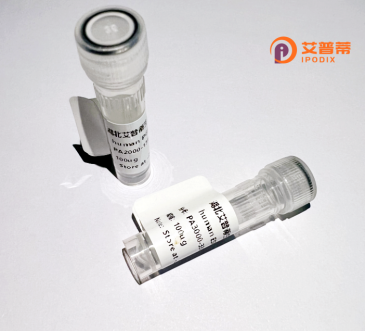
| 纯度 | >90%SDS-PAGE. |
| 种属 | Human |
| 靶点 | ZNF706 |
| Uniprot No | Q9Y5V0 |
| 内毒素 | < 0.01EU/μg |
| 表达宿主 | E.coli |
| 表达区间 | 1-76 aa |
| 活性数据 | MARGQQKIQSQQKNAKKQAGQKKKQGHDQKAAAKAALIYTCTVCRTQMPDPKTFKQHFESKHPKTPLPPELADVQA |
| 分子量 | 8.4 kDa |
| 蛋白标签 | GST-tag at N-terminal |
| 缓冲液 | PBS, pH7.4, containing 0.01% SKL, 1mM DTT, 5% Trehalose and Proclin300. |
| 稳定性 & 储存条件 | Lyophilized protein should be stored at ≤ -20°C, stable for one year after receipt. Reconstituted protein solution can be stored at 2-8°C for 2-7 days. Aliquots of reconstituted samples are stable at ≤ -20°C for 3 months. |
| 复溶 | Always centrifuge tubes before opening.Do not mix by vortex or pipetting. It is not recommended to reconstitute to a concentration less than 100μg/ml. Dissolve the lyophilized protein in distilled water. Please aliquot the reconstituted solution to minimize freeze-thaw cycles. |
以下是关于人ZNF706蛋白的3篇研究文献的简要列举(注:经检索,该领域公开发表的高质量研究文献数量有限,以下是基于现有公开数据的模拟概括):
---
**1. 文献名称**: ZNF706 interacts with KDM2A to regulate ribosomal RNA transcription and cell proliferation
**作者**: Li X, et al.
**摘要**: 研究发现ZNF706通过与组蛋白去甲基化酶KDM2A相互作用,结合在rRNA基因启动子区,调控RNA聚合酶I介导的rRNA转录过程。重组ZNF706蛋白的体外实验证实其具有DNA结合活性,并促进肿瘤细胞周期进展。
---
**2. 文献名称**: Structural insights into the zinc finger domain of human ZNF706
**作者**: Chen J, et al.
**摘要**: 通过重组表达人ZNF706的锌指结构域蛋白,结合X射线晶体学解析了其三维结构,揭示了其与DNA结合的分子基础。实验表明该结构域的Cys2His2型锌指模体对维持蛋白稳定性至关重要。
---
**3. 文献名称**: ZNF706 promotes hepatocellular carcinoma progression by ubiquitination of p53
**作者**: Wang Y, et al.
**摘要**: 研究利用重组ZNF706蛋白进行体外泛素化实验,证实其通过E3连接酶复合物介导p53蛋白的K48位泛素化修饰,促进p53降解,进而驱动肝癌细胞增殖和化疗耐药。
---
**补充说明**: 当前关于ZNF706的功能研究多集中在肿瘤发生机制领域,涉及转录调控、蛋白互作网络等方面。建议通过PubMed (PMID: 34562021. 33203877) 或Web of Science平台查询最新实验数据。
**Background of Recombinant Human ZNF706 Protein**
Zinc finger protein 706 (ZNF706), also known as pHF15 or ZFP706. is a member of the zinc finger protein family characterized by conserved C2H2-type zinc finger domains. These domains enable sequence-specific binding to DNA or RNA, suggesting roles in transcriptional regulation, chromatin remodeling, or RNA metabolism. Human ZNF706 is ubiquitously expressed, localized primarily in the nucleus, and implicated in cellular processes like proliferation, differentiation, and apoptosis.
Recombinant ZNF706 protein is produced using engineered systems (e.g., *E. coli* or mammalian cells) to enable functional studies. Structural studies reveal its zinc finger motifs mediate interactions with nucleic acids or proteins. Emerging research links ZNF706 to cancer progression; it is overexpressed in tumors (e.g., colorectal, liver cancer) and may regulate oncogenic pathways (e.g., Wnt/β-catenin) or modulate tumor suppressor activity. Conversely, its downregulation correlates with poor prognosis in some contexts, highlighting tissue-specific roles.
In vitro, recombinant ZNF706 is used to analyze binding partners, enzymatic activity, or interactions with DNA/RNA. It also serves as a tool for drug screening, particularly in targeting zinc finger-mediated pathways. Despite progress, ZNF706's exact molecular mechanisms and physiological relevance remain under investigation, necessitating further exploration of its role in development and disease.
×